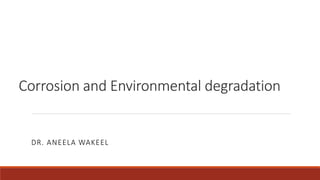
Corrosion and Environmental Degradation of Materials
- 1. Corrosion and Environmental degradation DR. ANEELA WAKEEL
- 2. Corrosion Although the term is usually applied to metals, all materials, including wood, ceramics (in extreme conditions) and plastics, deteriorate at the surface to varying degrees when they are exposed to certain combinations of sunshine (UV light), liquids, gases or contact with other solids. Corrosion is the deterioration of a material as a result of a reaction with its environment, especially with oxygen (oxidation). Electro-chemical corrosion can occur when; •Two different metals are involved •There is an electrolyte present •Metals are separated on the Galvanic Table (potential difference exists) •The metals are in contact
- 3. Degradation of Materials Plastics •It is widely accepted that plastics do not corrode however micro organisms which can decompose low density polyethylene do exist Plastics •Elastomers can cause other plastics to corrode or melt due to prolonged contact e.g. rubber left on a setsquare
- 4. Degradation of Materials Plastics •UV light will weaken certain plastics and produce a chalky faded appearance on the exposed surface Plastics •Heat will weaken or melt certain plastics even at relatively low temperatures Plastics •Cold can cause some plastics to become brittle and fracture under pressure
- 5. Degradation of Materials Plastics •Mould can grow on plastics in moist humid conditions Plastics •Bio-degradation – the chemical breakdown in the body of synthetic solid phase polymers
- 6. Degradation of Materials Metals •Most metals corrode because they react with oxygen in the atmosphere, particularly under moist conditions – this is called oxidation
- 7. RESULTS OF CORROSION Some of the major harmful effects of corrosion can be summarized as follows: 1. Reduction of metal thickness leading to loss of mechanical strength and structural 2. Hazards or injuries to people arising from structural failure or breakdown 3. Loss of time in availability of profile-making industrial equipment. 4. Reduced value of goods due to deterioration of appearance. 5. Contamination of fluids in vessels and pipes.
- 8. RESULTS OF CORROSION 6. Perforation of tanks and pipes allowing escape of their contents and possible harm to the surroundings. For example, corrosive sea water may enter the boilers of a power station if the condenser tubes perforate 7. Loss of technically important surface properties of a metallic component. These could include frictional and bearing properties, ease of fluid flow over a pipe surface, electrical conductivity of contacts, surface reflectivity or heat transfer across a surface. 8. Mechanical damage to valves, pumps, etc, or blockage of pipes by solid corrosion products. 9. Added complexity and expense of equipment which needs to be designed to withstand a certain amount of corrosion, and to allow corroded components to be conveniently replaced.
- 9. Galvanic Corrosion • Possibility when two dissimilar metals are electrically connected in an electrolyte* • Results from a difference in oxidation potentials of metallic ions between two or more metals. The greater the difference in oxidation potential, the greater the galvanic corrosion. • Refer to Galvanic Series (Figure 13-1) • The less noble metal will corrode (i.e. will act as the anode) and the more noble metal will not corrode (acts as cathode). • Perhaps the best known of all corrosion types is galvanic corrosion, which occurs at the contact point of two metals or alloys with different electrode potentials.